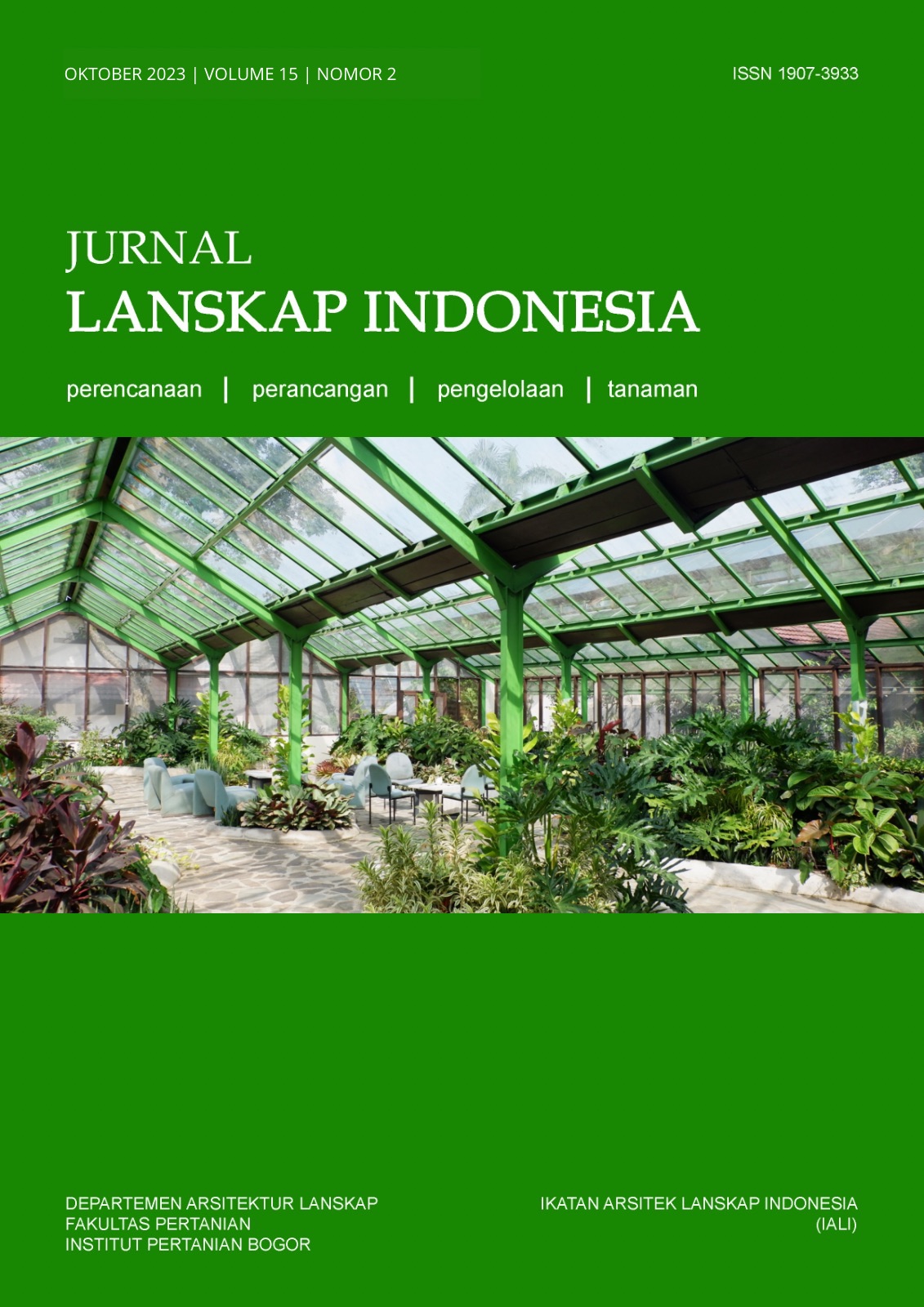Evaluasi Komposisi Elemen Lanskap Kandang Peragaan Taman Margasatwa Ragunan Berbasis Preferensi Pengunjung
Abstract
The shifting of the zoo perspective, from entertainment to being more conservation-oriented has brought positive impacts to environmental conservation. However, it also brought conflict where the need in improving animal welfare contradicted the efforts in increasing visitor satisfaction. This research aimed to evaluate the landscape element of zoo exhibits based on visitor preference as an alternative way to pursue a balance between this conflict. This research was conducted in Ragunan Zoo, Indonesia from 2019 to 2022. Two phases of the questionnaire were conducted during the research. The first questionnaire with a total of 99 respondents resulted that tiger, giraffe, and elephant became the most favorite animals. In opposite, snake, crocodile, and long-tailed macaque became the least favorite animals. In addition, the favorite landscape elements of the zoo’s exhibits were trees, water features, and woods/ log piles; while the least favorite landscape elements were stones, toys (environmental enrichment), and shrubs/climber plants. An in-depth questionnaire was conducted with a total of 37 respondents to understand the preference of landscape elements for visitor satisfaction and animal welfare through exhibit design model simulation. The study found that most respondents showed a positive value on high naturalistic exhibit design for animal welfare. However, the value of high naturalistic exhibits was lower when it comes to visitor satisfaction. It indicated that the presence of trees might reduce visitor’s visibility and overall satisfaction. The result of favorite and least favorite landscape elements slightly varies compared to the first questionnaire. Trees and water features became a consistent favorite landscape element, while toys became the least favorite one. However, the result was the opposite in the shrubs/climber plants element, as in this questionnaire, this element had a positive result in the most of evidence. In the case of stone and wood, the result might vary on animal species and the total area of the zoo’s exhibit.
Downloads
References
Adefalu, L.L., Omotesho, K.F., Alao, O.S. 2015. Determination of Visitor’s Preference for Wild Animal Species (A Case Study of Unilorin Zoo, Ilorin, Kwara State, Nigeria). Journal of Research in Forestry, Wildlife and Environmental. 7(1): 125-135. ISBN: 2141–1778.
Carr, N. 2016. An Analysis of Zoo Visitor’s Favourite and Least Favourite Animals. Tourism Management Perspectives. 20:70-76. https://doi.org/10.1016/j.tmp.2016.07.006
Fernandez, E.J., Tamborski, M.A., Pickens, S.R., Timberlake, W. 2009. Animal-visitor Interactions in the Modern Zoo: Conflicts and Interventions. Applied Animal Behaviour Science. 120(1-2): 1-8. https://doi.org/10.1016/j.applanim.2009.06.002
Rahmafitria, F., Hindayani, P. 2022. Integrasi Analisis Preferensi Visual dan Bahaya Lanskap dalam Perencanaan Wisata di Taman Hutan Raya Ir. H. Djuanda, Bandung. Jurnal Lanskap Indonesia, 14(2), 60-68. https://doi.org/10.29244/jli.v14i2.39833
Grazian, D. 2012. Where the Wild Things Aren’t: Exhibiting Nature in American Zoos. The Sociological Quarterly. 53(4):546-565. https://doi.org/10.1111/j.1533-8525.2012.01249.x
Ilhami, W.T, Gunawan, A. 2011. Persepsi dan Preferensi Warna dalam Lanskap. Jurnal Lanskap Indonesia. 3(2): 73-79. https://doi.org/10.29244/jli.2011.3.2.%25p
Islami, M.Z., Kaswanto, R.L. 2017. Landscape Design Process of Lakewood Nava Park BSD City Based on Smart Growth Concept. IOP Conference Series: Earth and Environmental 9(1) p. 012035. IOP Publishing.
Kementerian Kehutanan RI. 2012. Peraturan Menteri Kehutanan Republik Indonesia Nomor P.31/Menhut-II/2012 tentang Lembaga Konservasi. Jakarta [ID]: Kementerian Kehutanan RI.
Kisling, V.N., ed., 2000. Zoo and Aquarium History: Ancient Animal Collections to Zoological Gardens. CRC press.
Learmonth, M.J. 2019. Dilemmas for Natural Living Concepts of Zoo Animal Welfare. Animals. 9(6):318-331. https://doi.org/10.3390/ani9060318
Lee, H.S. 2015. Measurement of Visitors' Satisfaction with Public Zoos in Korea Using Importance-Performance Analysis. Tourism management. 47:251-260. https://doi.org/10.1016/j.tourman.2014.10.006
Maxted, N. 2013. In Situ, Ex situ Conservation. Encyclopedia of Biodiversity 4. Amsterdam: Elsevier.
Nafar, S., Shozo, S., and Tanaka, M. 2022. The Relationship of the Zoo Exhibits Landscape Design to Animal Welfare and Visitor Satisfaction in Kyoto City Zoo [Tesis]. Kyoto: Kyoto University.
Peraturan Pemerintahan RI. 1999. Peraturan Pemerintahan Republik Indonesia Nomor 7 tahun 1999 tentang Pengawetan Jenis Tumbuhan dan Satwa. Jakarta [ID]: Presiden Republik Indonesia.
Rose, P.E., Nash, S.M., and Riley, L.M. 2017. To Pace or Not to Pace? A Review of What Abnormal Repetitive Behavior Tells Us about Zoo Animal Management. Journal of Veterinary Behavior: Clinical Applications and Research. 20:1-21. https://doi.org/10.1016/j.jveb.2017.02.007
Xu, W., Zhao, J., Huang, Y., Hu, B., 2018. Design Intensities in Relation to Visual Aesthetic Preference. Urban Forestry & Urban Greening, 34, pp.305-310.
Copyright (c) 2023 Sholihin Nafar, Andi Gunawan, Nurhayati

This work is licensed under a Creative Commons Attribution 4.0 International License.
This journal permits and encourages authors to post items submitted to the journal on personal websites or institutional repositories both prior to and after publication, while providing bibliographic details that credit, if applicable, its publication in this journal. However, after the article is submitted and published in this journal, it is fully copyrighted by the Jurnal Lanskap Indonesia or JLI. If excerpts from other copyrighted works are included, the author must obtain written permission from the copyright owner and give credit to the source in the article. Then, the writer or reader is allowed to copy, share, and redistribute articles/material in any form. But it must still include the appropriate source and credit because the article in this journal is licensed by Creative Commons Attribution 4.0 International License (CC BY 4.0).
I. Proposed Policy for Journals That Offer Open Access
Authors who publish with this journal agree to the following terms:
- Authors retain copyright and grant the journal right of first publication with the work simultaneously licensed under a Creative Commons Attribution License that allows others to share the work with an acknowledgement of the work's authorship and initial publication in this journal.
- Authors are able to enter into separate, additional contractual arrangements for the non-exclusive distribution of the journal's published version of the work (e.g., post it to an institutional repository or publish it in a book), with an acknowledgement of its initial publication in this journal.
- Authors are permitted and encouraged to post their work online (e.g., in institutional repositories or on their website) prior to and during the submission process, as it can lead to productive exchanges, as well as earlier and greater citation of published work (See The Effect of Open Access).
II. Proposed Policy for Journals That Offer Delayed Open Access
Authors who publish with this journal agree to the following terms:
- Authors retain copyright and grant the journal right of first publication, with the work after publication simultaneously licensed under a Creative Commons Attribution License that allows others to share the work with an acknowledgement of the work's authorship and initial publication in this journal.
- Authors are able to enter into separate, additional contractual arrangements for the non-exclusive distribution of the journal's published version of the work (e.g., post it to an institutional repository or publish it in a book), with an acknowledgement of its initial publication in this journal.
- Authors are permitted and encouraged to post their work online (e.g., in institutional repositories or on their website) prior to and during the submission process, as it can lead to productive exchanges, as well as earlier and greater citation of published work (See The Effect of Open Access).



























